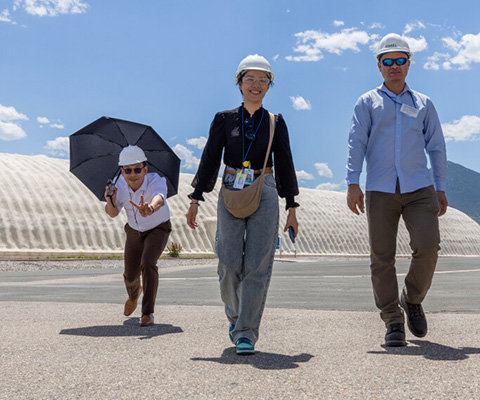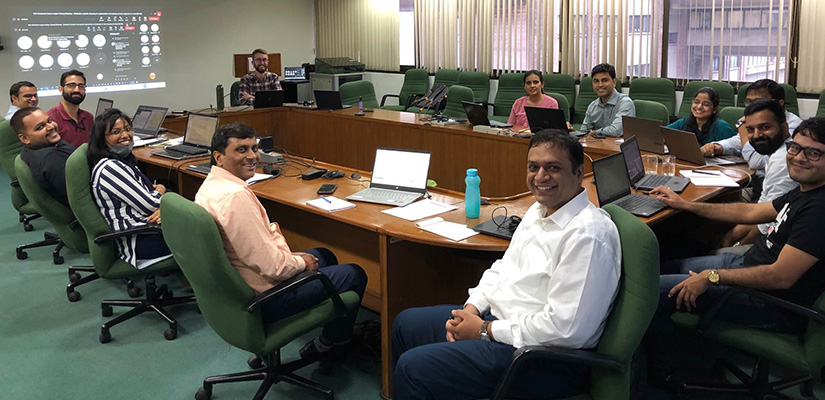NREL's International Work Bridges Innovation and Development―With Benefits at Home and Abroad
From Electrifying Colombia’s Rural Communities to Making Renewable Integration Safer, NREL Researchers Advance Development and Innovation Across the Globe
The National Renewable Energy Laboratory's (NREL's) partnerships with the U.S. Agency for International Development (USAID), the U.S. Department of State, the U.S. Department of Energy, and countries and organizations across the globe are accelerating social, technical, and economic development worldwide. These collaborations are also creating opportunities to expand and enhance NREL's research and analysis in new and exciting ways.
"Technical experts from NREL bring cutting-edge research, analysis, and tools to the challenges our USAID partners face, and they work with our partners to build in-country expertise," USAID Clean Energy Coordinator Kristen Madler said. "When country partners come to us with a technical challenge that's new to them, they are reassured when they learn others have gone through something similar. USAID partners have peace of mind and a sense of camaraderie when they learn that the people providing guidance have dealt with these challenges in other places."
Madler, as one of several leads in the USAID-NREL Partnership, helps coordinate efforts that combine USAID's strategic reach with NREL's technical expertise.
"USAID benefits from being able to tap into the wide-ranging, specialized knowledge of NREL researchers, many of whom come from the same areas and speak the languages of USAID partners," Madler said. "In turn, NREL researchers grow the laboratory's capabilities and use their tools and analysis in new environments. It's a mutually beneficial relationship."
Partnerships With Laos, Colombia, and India Accelerate Innovation and Build Capacity
NREL has partnered with many countries around the world, including Laos, Colombia, and India, to enable energy deployment and innovation that meets the needs of diverse communities. These partnerships also help accelerate innovation in the United States. By working closely with local stakeholders, NREL is developing tailored solutions that go beyond technology, fostering sustainable development.
"There are instances of development and underdevelopment in all countries, including our own," said NREL project leader Derina Man, who oversees much of NREL's programming in Southeast Asia. "Forging partnerships in other countries creates opportunities for NREL to think about technology problems in a different way so that we are finding solutions that can be applicable to a broader range of people. We learn how countries are addressing similar challenges to what we face here in the United States, and we get to apply solutions here at home."
Supporting Laos' Transportation Transformation

In Laos, NREL has been supporting efforts to innovate the country's transportation system. Man was part of the team that translated and adapted NREL's Open Platform for Agile Trip Heuristics (OpenPATH™) tool to track Laos volunteers' travel patterns, enabling the team to learn more about how citizens use the current transportation system and where it can be improved, not just electrified.
When the Laos travel data was disaggregated by gender, researchers found that women tended to make two to three more stops per trip than men, in addition to making different choices about where and when to use public transportation.

"We don't have a great sense, even in America, of how women move versus how men move—and the way bus routes, subway systems, and infrastructure are designed does not accommodate that," Man said. "This open-access dataset is now available to governments and researchers to understand how we can make the transition to electric public transportation in a way that will benefit everyone more equally."
This dataset will enable Laos to find new ways to serve the population through public transit—a feat made possible by the trust both parties worked to establish.
"It's essential to build trust," Man said. "Laos partners needed to trust that NREL was providing data-driven suggestions without trying to influence their decision-making. We needed to understand what their needs were and how best to partner with them to provide the best tools to meet their goals. Our researchers spent years forging relationships to understand the right tools to use in such a resource-constrained environment, which will be helpful as we produce work for other, similar environments."
Electrifying Colombia's Rural and Informal Communities

In Colombia, NREL is working with USAID and the Colombian government and its agencies to increase electrification to some of the country's most marginalized rural and urban communities.
Roughly 3% of the Colombian population does not have electricity and lives across about 90% of the nation's land.
"When you look at the numbers, you say, well, it's great that 97% of the country has electricity, but what about that 3%? Providing electricity to these rural and remote populations is very challenging," said NREL data scientist Galen Maclaurin, who is part of the team of researchers supporting these efforts in Colombia, along with NREL's lead for Latin America, Daniella Rough.
A unit within Colombia's Ministry of Mines and Energy is working with NREL to use the open-source tool REopt® to optimize energy generation, transmission, storage, and cost. NREL provides expertise in using the tool as well as technical assistance to solve challenges like replacing diesel generators with solar systems and energy storage in extremely rural areas.
In Colombia's cities, some communities connect to electricity informally, which can be very dangerous. The Colombian government refers to these communities as "informal communities" and is working with NREL and the utility in Cartagena to help communities in that city formalize. The goal is to create reliable and safe access to electricity that is also affordable and fair, potentially through community solar, where communities could have ownership of a solar installation that would also offset the cost of electricity.
Working globally presents NREL with opportunities to develop or adapt open-source tools, which not only extend the impact of the laboratory's research but also amplify the value of U.S. investments in these tools.
"NREL is helping to develop new technologies, new models, new data, and new approaches, and it's fundamental that we share those as broadly as we can and train others on how to use them," Maclaurin said.
Learn more about USAID and NREL's Colombia partnership.

Expanding Access to Consistent Renewable Power on India's Diverse Power Grid

India has a goal of reaching 500 GW of renewable electricity capacity by 2030—no mean feat for one of the fastest growing power systems on Earth. To help enable the country's ambitious energy goals, NREL adapted its Regional Energy Deployment System (ReEDS™) model specifically for the Indian context.
By adapting ReEDS to India, NREL researchers studied the impact on India's grid of bringing on more renewable resources if the country were to retire legacy coal plants. In the process, the researchers gathered lessons that will translate far beyond India.
Ilya Chernyakhovskiy, NREL grid analyst, said, "We are now taking those lessons learned to use ReEDS in specific environments, both in the United States and abroad. Currently, we're adapting the model for various U.S. utilities and state energy offices as well as international contexts, and much of what we learned about applying the tool in India and elsewhere is making that possible."
Using tools designed by NREL, the government of India and its Power System Operation Corporation were better able to understand how policies and energy sector trends—including adoption of hydrogen, pumped storage hydropower, solar photovoltaics, and other renewable energy sources—will affect India's electric grid and meet the country's growing electricity demands.
Learn more about NREL's collaborations with India's power sector.

NREL's Partnerships With USAID and Beyond Leverage Strengths in Science and Diplomacy
For over a decade, USAID and NREL have leveraged each other's complementary capabilities and investments to do more together than they could alone. To date, this partnership has mobilized more than $1.5 billion in investment, informed more than 60 laws, policies, and plans, and trained more than 11,000 individuals across 55 countries.
NREL benefits from USAID's and the U.S. Department of State's longstanding relationships with local organizations and diplomatic networks that facilitate research. In return, NREL's scientific objectives and expertise complement these agencies' diplomatic and philanthropic strengths.
Where USAID addresses development and social challenges that intersect with advanced energy, NREL brings technical expertise to support those efforts.
NREL's focus on stakeholder engagement is at the heart of its international partnership approach, as presented in "Strategies and Good Practices To Support Robust Stakeholder Engagement In Multi-Sector Energy Transition Planning." Working with stakeholders on development challenges also allows NREL to advance research and innovation collaboratively with these partners.
NREL's Open-Source Tools and Data Become Part of Solutions Around the Globe
NREL is one of the founding members of the Global Power System Transformation Consortium (G-PST), working on technical analysis with electrical system operators and research institutions from around the world. Participation in this global initiative enables NREL to develop solutions with immediate adoption and impact.
For example, after G-PST partnered with system operators to identify the need for a simple tool to monitor system inertia on electrical grids, NREL responded by developing an open-source tool designed for easy integration into any power system.
The ability to observe inertia levels is essential for safely introducing more inverter-based renewable energy into a system. Utilities worldwide can use this tool to confidently assess opportunities to integrate renewable energy onto their power grids.
G-PST's Open Data and Tools Portal documents free and open-source software tools and datasets that can be used to plan and operate advanced power systems. It currently contains information on 37 software tools from 22 organizations.
"Our collaborations with G-PST members allow us to identify where we can provide something new and immediately useful in enabling reliable, affordable, and secure grids around the world," said Karin Wadsack, NREL researcher and executive director of the G-PST secretariat. "Our international work allows NREL researchers to keep our finger on the pulse of what's important in the world."
By continuing to build the laboratory's international programs and partnerships, NREL ensures that its unique scientific expertise contributes to a shared, sustainable future, benefitting communities from Colorado to Colombia and beyond.
To find out more about the laboratory's international work, visit NREL's International Activities site.
This article has been updated to reflect an editorial change made after its original publication.
Last Updated May 28, 2025
